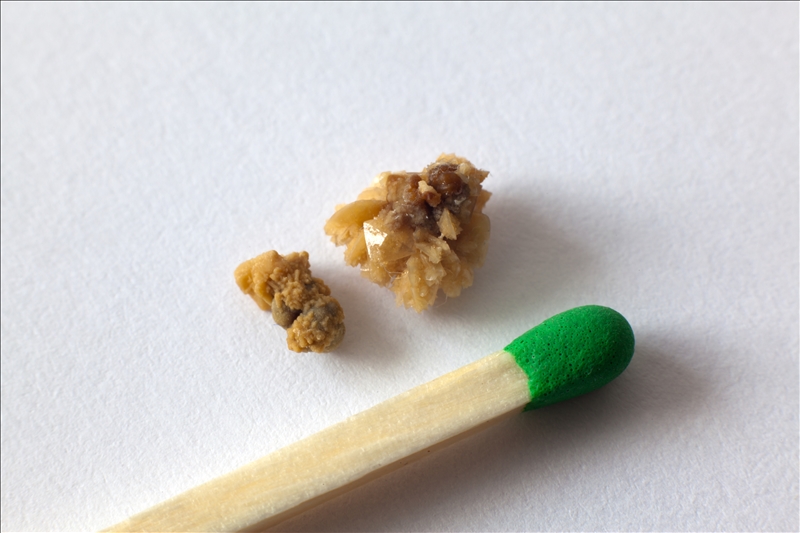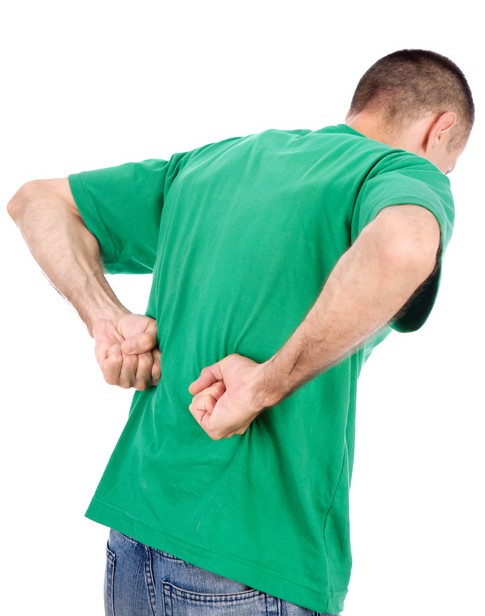Kidney stones are usually pretty small, but they sure can pack a big wallop. Wendy MacGregor, who passed her first kidney stone 30 years ago and has had a least a dozen stones since, says the pain can be unbearable. “I always know when it’s coming on,” she says, “because there is a certain area in my back where all of a sudden there is pain and I know what I’m in for. It ends up being the most excruciating pain and I have to drive myself to the emergency room because I can’t take it any longer.”
When Wendy passed a stone last year, it was so big she had to have surgery to get rid of it because it couldn’t pass on its own. After, she was referred to the Maine Medical Partners Kidney Stone Prevention Program, which opened in South Portland last June under the direction of Dr. Eric Taylor. He’s a nephrologist or kidney specialist and his main focus is preventing people like Wendy from suffering with any more kidney stones. “We’re pretty excited about the program,” he told me recently. “It’s the first and only comprehensive kidney stone prevention program in New England. It’s a collaborative effort between urologists and the surgeons who remove kidney stones.”
It’s the focus on preventing rather than simply treating kidney stones (in adults and children) that sets the program apart says Dr. Taylor. The number one message he wants to get across is that recurring kidney stones can be prevented, something he thinks many people, including physicians, don’t realize. The first step is to figure out what caused them in the first place. “Kidney stone type is important,” he says, “but even when two people have the same type you really have to tailor your therapy to that individual patient. What that involves, at a minimum, is an evaluation of a 24-hour urine sample. Without that, you can’t give effective advice about stone prevention.”
Types and causes of kidney stones
There are four different types of kidney stones. Each has a different cause and may require a different approach to prevention.
- Calcium – These are the most common type of kidney stones. They occur in two major forms: calcium oxalate and calcium phosphate. Calcium oxalate stones are the most common and can be caused by a large number of different lifestyle, dietary, genetic, and urine factors.
- Struvite – This type of kidney stone affects women more than men, and is caused by having kidney infections. Effectively treating the kidney infection helps prevent this type of stone.
- Uric acid – This type of stone forms when the urine is too acidic. Acidic urine can be caused by diet and/or other diseases, such as diabetes, gout, and obesity.
- Cystine – These stones are very rare. They are caused by a genetic (inherited) kidney disease called cystinuria, which causes a substance called cystine to leak through the kidneys into the urine where it forms crystals that can build up into stones.
Stones often linked to other medical problems
In the last 20 years there has been a dramatic increase in kidney stones — the lifetime prevalence is about one in 11 for men and women. Although they form in the kidney they are often linked to a wide variety of other medical conditions and diseases.
- Osteoporosis (weak or brittle bones)
- High blood pressure
- Over active parathyroid
- Obesity
- Type 2 diabetes
- Chronic kidney disease
- Bowel diseases, such as inflammatory bowel disease (ulcerative colitis, Crohn’s disease), loss of bowel through surgery, and altered bowel function from bariatric (weight loss) surgery for obesity
- Cystic fibrosis
Once the 24-hour urine sample has been analyzed, the type of stone a person’s body makes identified, and whether there are any other underlying medical conditions determined, the next step is to develop an individualized kidney stone prevention plan. It’s likely to include lifestyle and changes in the diet. It may also include medication. It will definitely require a commitment.
What Wendy discovered about her kidney stones
Wendy was astonished by what she learned from her evaluation with Dr. Taylor. “I had always been told that it was dairy or calcium that was causing my stones so I really watched my dairy intake and come to find out it was sodium. All these years I had been avoiding as much calcium as possible, making sure it wasn’t in my vitamins. I wasn’t drinking much milk or eating much ice cream, things like that. And it’s totally the opposite.”
Dr. Taylor advised Wendy to drink more fluids, which helps keep urine diluted so crystals can’t form and flushes away materials that might form stones. He also told her to stay under 2000 mg of sodium per day. Easier said than done. Even frozen dinners that she assumed were healthy because the label said so, sometimes contained almost her entire daily allowance. Sodium seemed to be in everything. “Just one teaspoon of salt is 2300 milligrams,” she says. “It really has gotten me to read labels and food that I normally like, like pickles and ketchup and even a rotisserie chicken at the grocery store is high in sodium.”
Kay Mullin, a registered dietician at the Kidney Stone Prevention Program, helped Wendy figure things out. Whenever Dr. Taylor recommends any dietary changes, he turns to Kay to help patients make those changes. “I’m trying to help people navigate nutrition with the guidelines from Dr. Taylor,” she explains. “Most people, even though they can feel overwhelmed at first, leave with the knowledge of more foods that they can eat rather that feeling as restricted as they did, especially those who just pulled information about kidney stones off the Internet. Really, what I’m promoting is an unprocessed, well-balanced diet.”
Wendy says learning what she did about preventing kidney stones turned her life around. “I’ve lost about 25 pounds since I started,” she says. “It’s really just made me so aware of what I’m eating and I’m constantly looking at labels, not only the calories and fat, but also the sodium. I wish that I’d know this 30 years ago when this all started.”
The true test will be whether or not Wendy ever has another stone. Some people still end up needing medication. What’s most important to understand, believes Dr. Taylor, is that too many people don’t realize kidney stones are preventable. “It’s frustrating,” he says, “to see patients who have had horrible stone disease for decades and have never been told there are things you can do about it.”
For more information, visit the MMP Kidney Stone Prevention Program website.
Also, check out the Catching Health Calendar to learn about Healthy Eating and Weight Control: A four part series to promote weight change that Kay is presenting beginning January 28.
Sign up for the Catching Health Newsletter
Google[/fusion_builder_column][/fusion_builder_row][/fusion_builder_container]



http://www.mainehealth.org/mmp_kidney_stone_home.cfm?id=8866
Not really helpful, just a place to email this doctor?
The website for the MMP Kidney Stone Prevention Program has five links to additional information just below the title of the program and image of doctor and patient. Red blocks with white lettering. They are easy to miss at first glance. Let me know if you still don’t see them.